Common Sneezeweed
(Helenium autumnale)
Common Sneezeweed (Helenium autumnale)
/
/

aarongunnar
CC BY 4.0























































Estimated Native Range
Summary
Common Sneezeweed is valued for its late-season blooms, which add vibrant color to gardens when many other plants have finished flowering. It is often used in borders, wildflower gardens, and as cut flowers. This plant is adaptable to a range of soil moisture conditions and is known for its ease of maintenance. It thrives in full sun but can tolerate part shade and requires soils with good drainage. While generally pest-free, it can be susceptible to powdery mildew and leaf spot. Cultivars offer variations in color and height, with some being more compact or having flowers in shades of orange, red, and brown.CC BY-SA 4.0
Plant Description
- Plant Type: Herb
- Height: 3-5 feet
- Width: 2-3 feet
- Growth Rate: Rapid
- Flower Color: Orange, Red, Yellow
- Flowering Season: Fall, Summer
- Leaf Retention: Deciduous
Growth Requirements
- Sun: Full Sun
- Water: Medium
- Drainage: Fast, Medium, Slow
Common Uses
Bee Garden, Bird Garden, Border Plant, Butterfly Garden, Deer Resistant, Drought Tolerant, Groundcover, Hummingbird Garden, Low Maintenance, Rabbit Resistant, Salt Tolerant, Showy Flowers, Street Planting, Water Garden
Natural Habitat
Moist meadows, wet prairies, along streams, and damp open woodlands
Other Names
Common Names: Fall Sneezeweed, Mountain Sneezeweed, Large-Flowered Sneezeweed, Solbrud, Bitterweed, False Sunflower
Scientific Names: , Helenium autumnale, Helenium autumnale var. montanum, Helenium autumnale var. grandiflorum, Helenium autumnale var. fylesii, Helenium autumnale var. parviflorum, Helenium autumnale var. autumnale, Helenium montanum, Helenium autumnale var. canaliculatum, Helenium commutatum
GBIF Accepted Name: Helenium autumnale L.